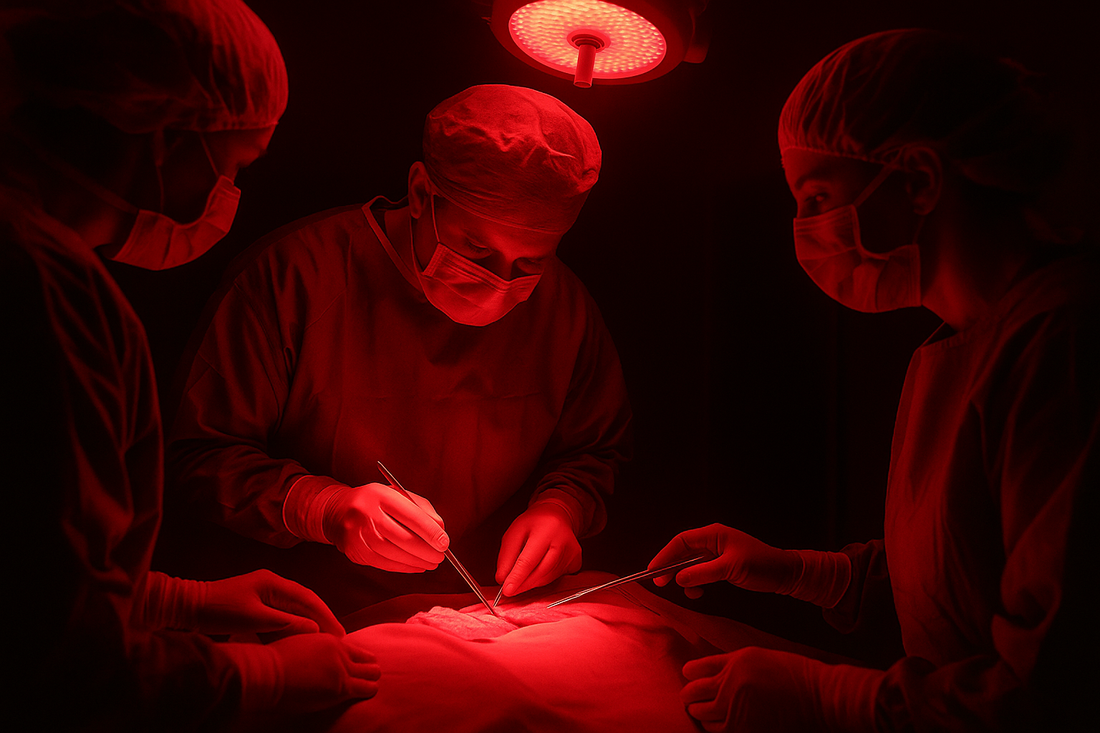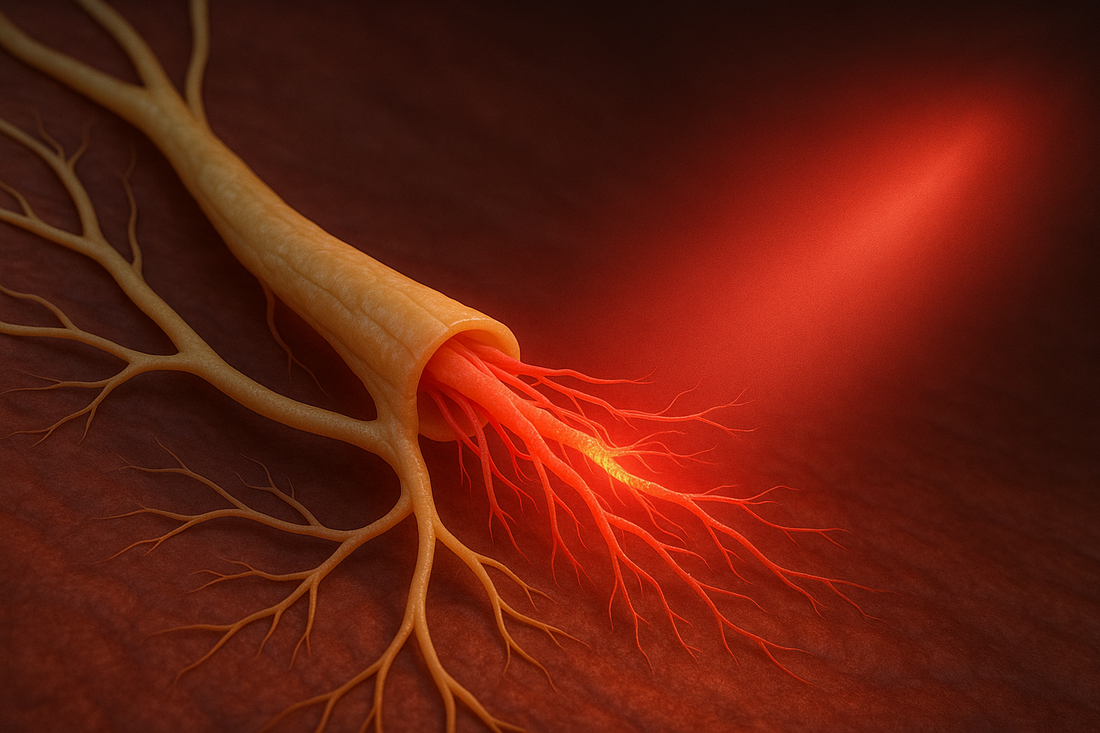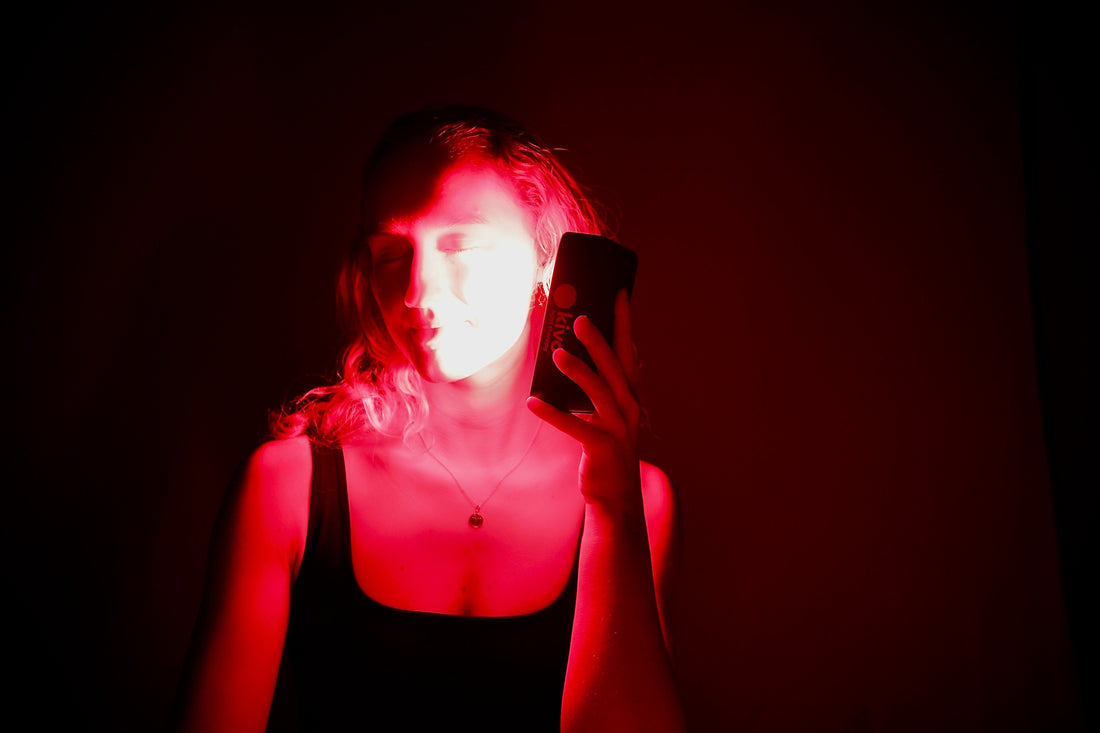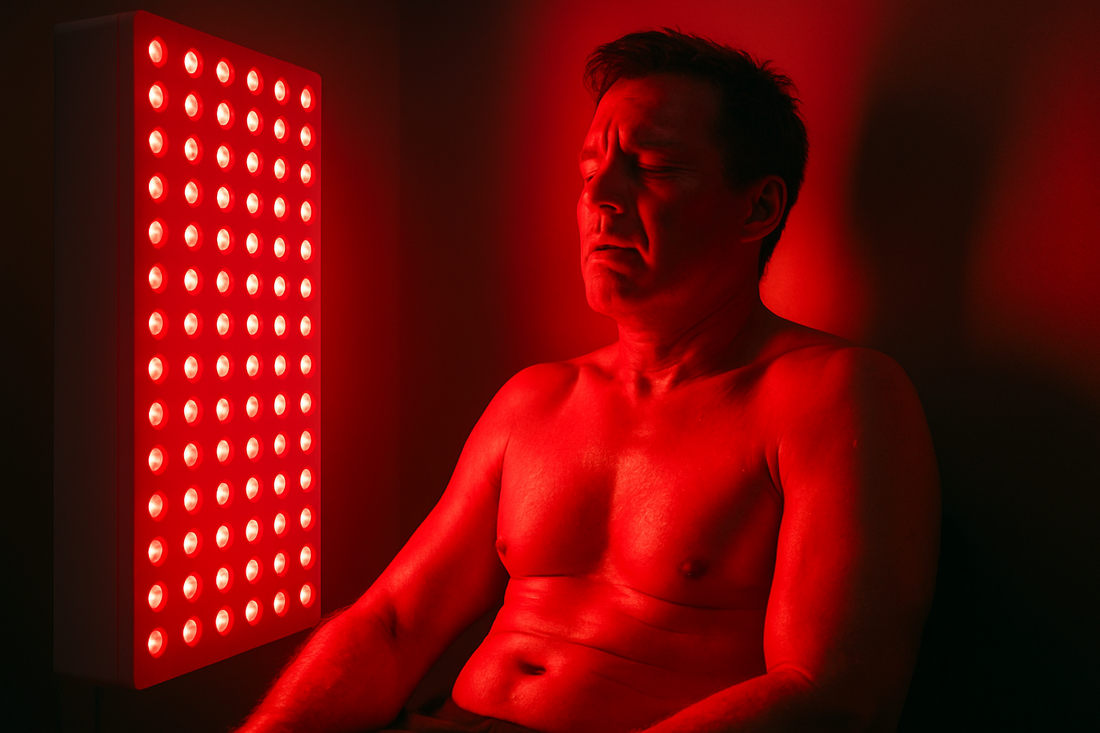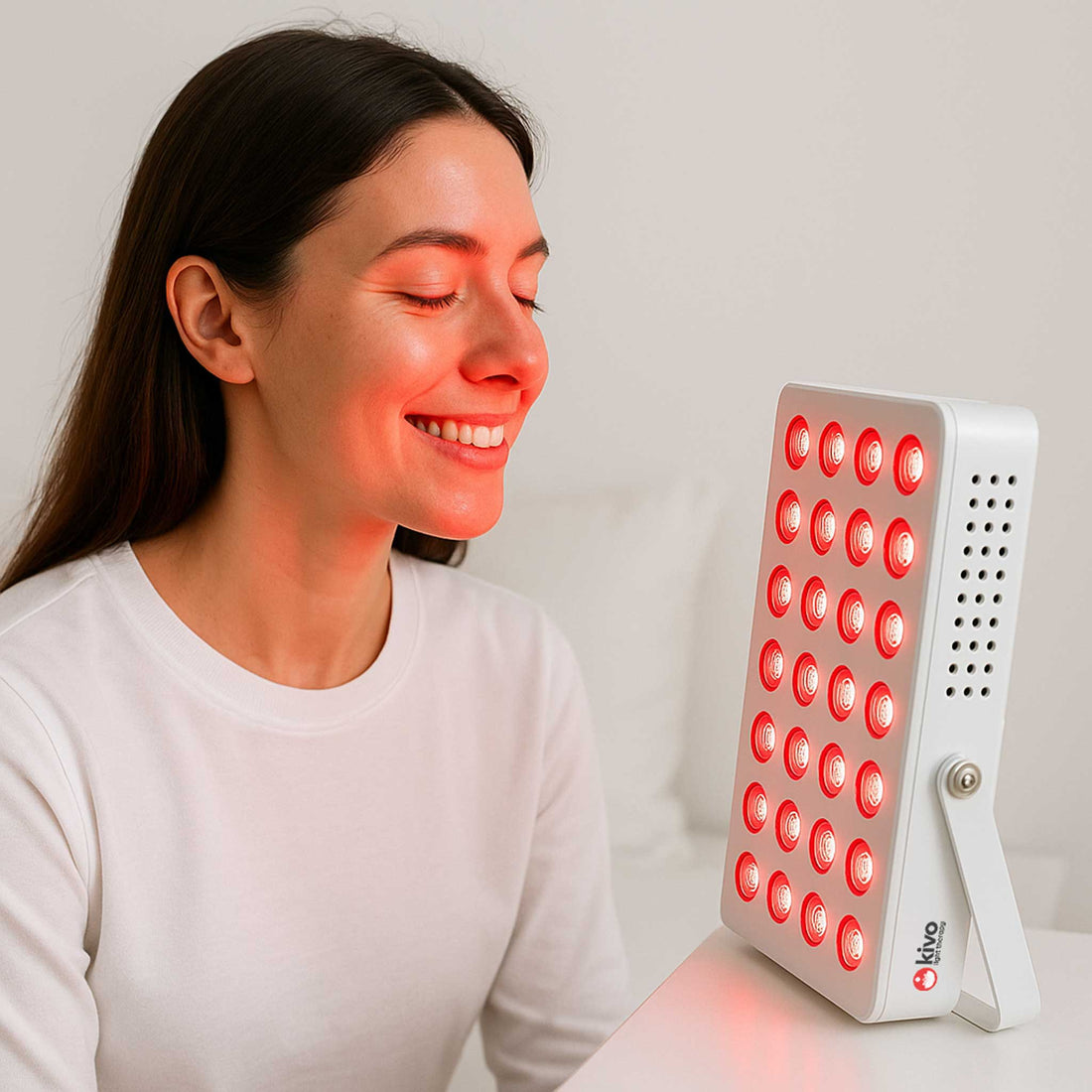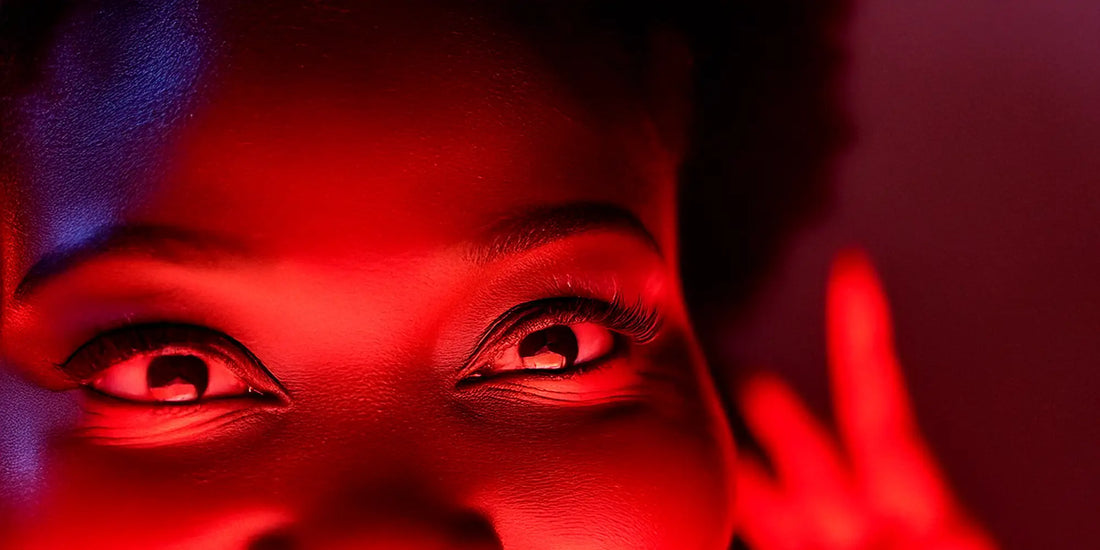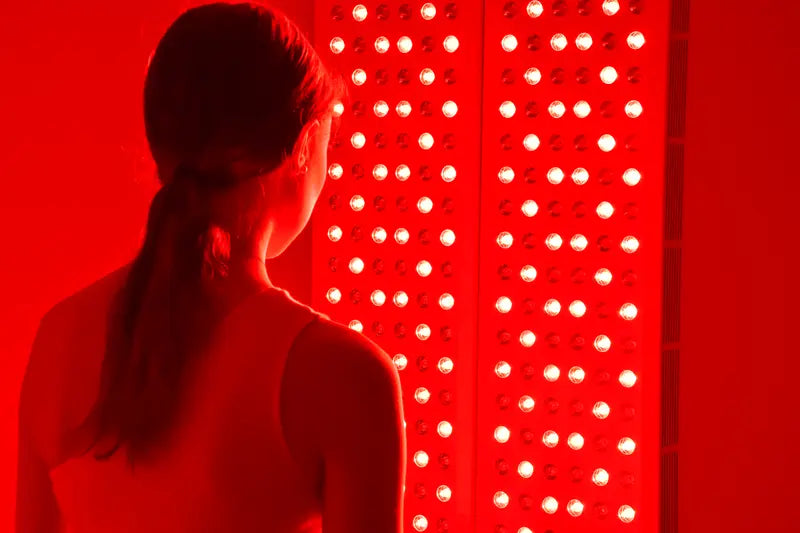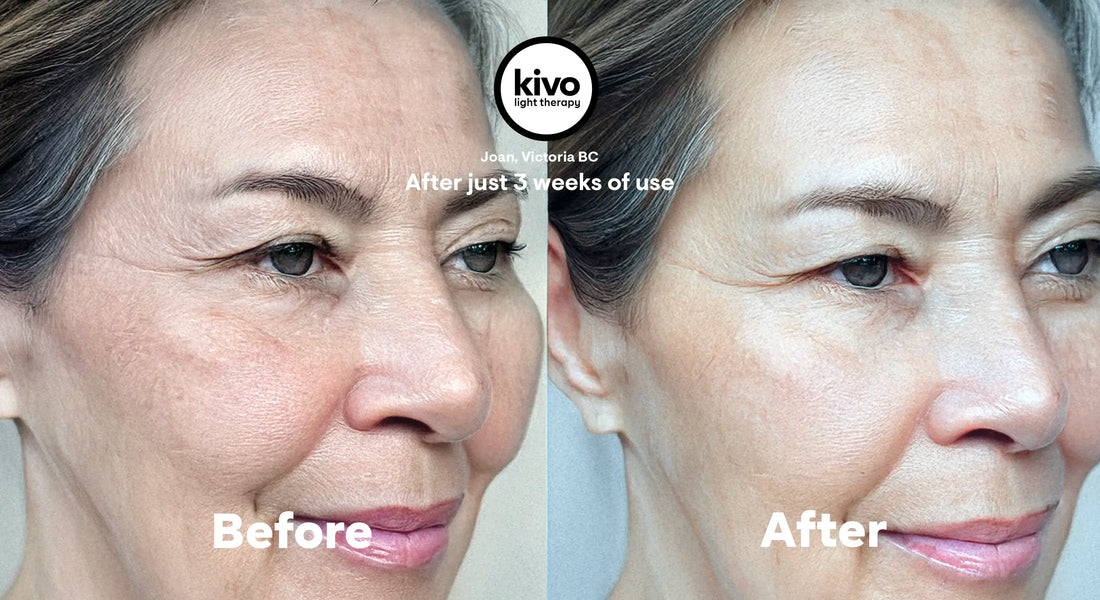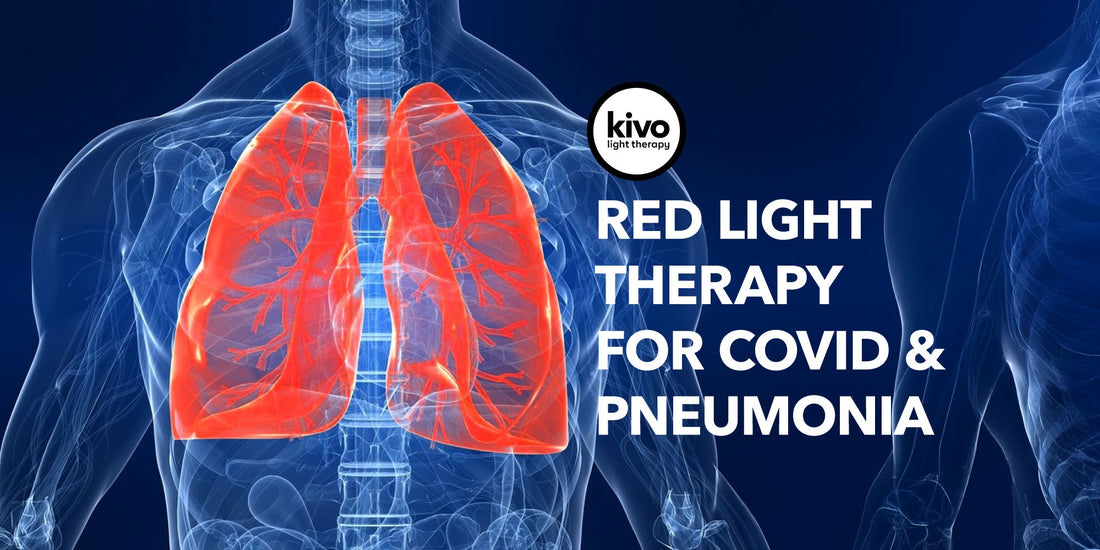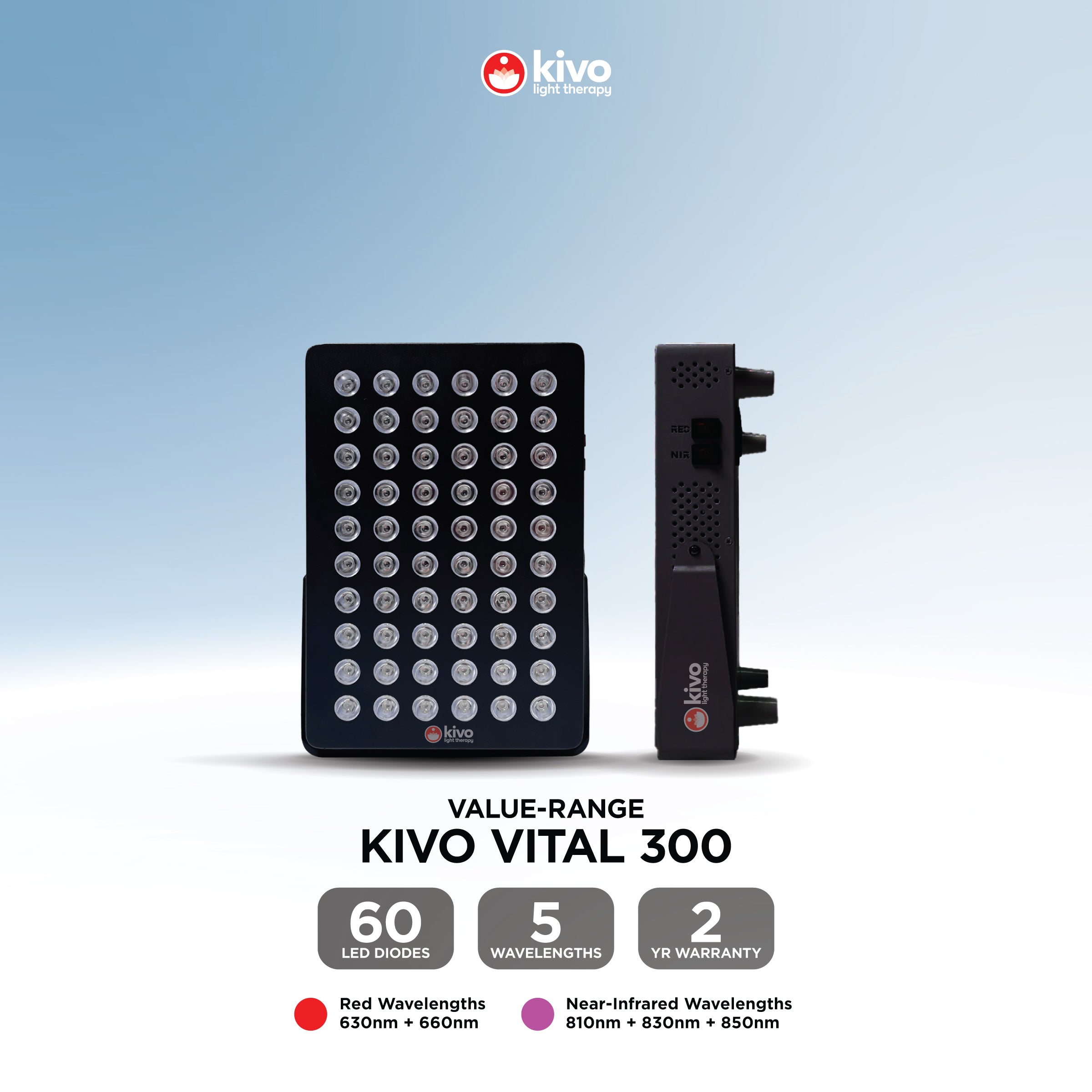Learn about Red Light Therapy
Red Light Therapy Dosage Calculator
Getting the right dosage of Light Therapy is crucial to obtaining the results you're looking for. Our exclusive algorithm takes into account the outcomes of thousands of customers, feedback, as well as the results of numerous scientific studies, we've built a red light therapy dosage calculator that takes in the irradiance of a device, the distance you want to use it, whether you're changing brightness / pulse modes / treatment type, and takes all of that into account to calculate the correct dosage you need. Red Light Dosage Calculator
Learn moreRed Light & Near-Infrared Therapy for Concussions & Head Injury Recovery
Red and near-infrared light therapy—also known as photobiomodulation—is emerging as a promising treatment for concussions and brain injuries. By boosting cellular energy, improving blood flow, and reducing inflammation, red light helps the brain recover naturally after trauma. Clinical studies from institutions like Mass General Hospital and JAMA Network show it can improve brain connectivity, memory, and mood following head injuries.
Learn moreHow Red Light & Near-Infrared Therapy Can Optimize Pre-Op and Post-Op Surgical Recovery
Red and near-infrared light therapy (often called photobiomodulation) can be a powerful ally before and after surgery. By boosting cellular energy, improving circulation, and reducing inflammation, this safe, non-invasive treatment helps your body recover faster, with less pain and smoother healing. When used pre-surgery, it “preconditions” tissues for better resilience, and post-surgery it supports faster wound repair and scar reduction.
Learn moreRed and Near-Infrared to help Nerve Regeneration
Nerve damage is one of the most challenging conditions to treat. Whether caused by injury, surgery, diabetes, or chronic illnesses, damage to peripheral nerves often leads to pain, numbness, tingling, and impaired function. Unlike skin or muscle, nerve tissue regenerates very slowly, and in some cases, healing is incomplete. Traditional treatments often focus on managing symptoms rather than repairing the underlying damage. In recent years, however, there has been growing interest in a non-invasive approach that may support the body’s ability to repair nerve tissue: red and near-infrared (NIR) light therapy, also known as photobiomodulation (PBM). Studies are beginning to show that PBM can stimulate cellular repair processes, improve circulation, and enhance recovery in nerve-related conditions. So, how does this work — and what does the science say? How Red and Near-Infrared Light Affect Nerve Cells Both red light (around 630–660 nm) and near-infrared light (around 810–850 nm) penetrate tissues and are absorbed by mitochondria, the “powerhouses” of cells. Specifically, they target an enzyme called cytochrome c oxidase, which is part of the mitochondrial respiratory chain. When stimulated by these wavelengths, mitochondria produce more ATP (adenosine triphosphate) — the energy currency of the cell (NIH). In nerve cells, this extra energy allows for: Axonal repair: Damaged axons (the long projections of neurons) can regrow when energy demands are met. Myelin regeneration: Light therapy may support the repair of myelin, the protective sheath around nerves that is critical for fast and accurate signal transmission. Protein synthesis: Increased ATP fuels the creation of structural proteins needed for nerve repair. In short, light therapy helps “recharge” injured nerves so they can carry out the demanding process of repair. Reducing Oxidative Stress and Inflammation Nerve injury often creates an environment of oxidative stress, where excessive reactive oxygen species (ROS) damage cellular components. Photobiomodulation helps normalize ROS levels by making mitochondria more efficient. This not only protects neurons but also reduces secondary damage that can occur after the initial injury. In addition, light therapy reduces inflammatory cytokines — signalling proteins that can prolong pain and impair healing. By calming the inflammatory response, PBM creates a more favorable environment for regeneration. Research in the Journal of Neurotrauma found that NIR therapy not only reduced oxidative stress but also improved functional recovery after nerve injury (PubMed). Stimulating Neurotrophic Factors One of the most promising findings is that red and NIR light increase levels of neurotrophic factors. These are proteins that guide nerve growth, survival, and function. Among the most important are: Nerve Growth Factor (NGF): Promotes survival and growth of sensory and sympathetic neurons. Brain-Derived Neurotrophic Factor (BDNF): Supports synaptic plasticity, learning, and repair. A study published in Neuroscience Letters found that PBM increased expression of BDNF and NGF in animal models, leading to enhanced axon regeneration and functional recovery (NIH). This means that light therapy doesn’t just provide energy; it also helps activate the genetic and molecular programs necessary for nerves to rebuild themselves. Improving Circulation and Nutrient Delivery Nerves, especially peripheral nerves, have limited blood supply compared to other tissues. Poor circulation can slow healing and leave damaged nerves starved of oxygen and nutrients. Near-infrared light penetrates deeper than red light and stimulates nitric oxide release, which relaxes blood vessels and improves microcirculation. A study in Lasers in Surgery and Medicine demonstrated that animals treated with NIR after nerve injury had faster functional recovery and improved nerve conduction velocity compared to controls (PubMed). Improved blood flow is key not only for repair but also for clearing out metabolic waste products that accumulate in injured tissues. Evidence from Clinical and Preclinical Studies While much of the research has been done in animal models, the results are encouraging - and early human studies are beginning to confirm the benefits. Peripheral nerve injury: Animal studies show that PBM accelerates axonal regrowth and improves recovery of motor and sensory function. Carpal tunnel syndrome: Clinical trials using NIR light have reported reductions in pain and improvements in grip strength and nerve conduction (PubMed). Diabetic neuropathy: Studies suggest that PBM reduces pain and numbness while improving quality of life for patients with diabetic nerve damage. Post-surgical nerve recovery: Patients treated with red/NIR light after surgery have shown reduced pain, less inflammation, and better long-term functional outcomes. Although more large-scale clinical trials are needed, the existing data strongly suggest that photobiomodulation is a safe and effective adjunct therapy for nerve regeneration. What Patients Report Beyond the lab, many people using red and near-infrared therapy devices report improvements such as: Reduced tingling and numbness Decreased nerve pain Improved muscle activation in affected areas Better coordination and grip strength While individual results vary, these reports align with the physiological mechanisms demonstrated in research. Suggested Protocol for Nerve Regeneration (Using the Kivo Elite Panel) If you are considering red and NIR light therapy at home, consistency is key. Nerve healing is slow, and results are usually seen over weeks to months. A commonly recommended protocol is: Wavelength: Red + Near-Infrared Brightness: High (Level 5 on Kivo Elite Panel) Pulse: 40 Hz (associated with neurological repair and brain wave entrainment) Duration: 15–20 minutes per affected area Frequency: 5–7 times per week Treatment Length: At least 8–12 weeks, longer for chronic conditions This can be used alongside conventional treatments such as physical therapy, medications, and lifestyle interventions. Always consult a healthcare provider before starting new therapies, especially if you have a medical condition. For more Light Therapy Treatment Protocols, visit our help site: https://help.myKivo.com Why This Matters Nerve damage can be life-changing, affecting mobility, sensation, and independence. Traditional medicine often offers limited solutions beyond pain relief. Light therapy represents a shift — instead of masking symptoms, it seeks to help the body heal itself. As the research base expands, red and near-infrared therapy may become a standard part of nerve rehabilitation protocols, both in clinics and at home. Devices like the Kivo Elite Panel make it possible to access this promising therapy safely and consistently. For those dealing with nerve injuries, neuropathy, or post-surgical recovery, photobiomodulation offers real hope: faster healing, less pain, and a better chance of regaining function.
Learn moreADHD and Red Light Therapy
ADHD is more than just a buzzword these days. With rising diagnoses across all age groups, more people are looking for drug-free alternatives to help manage symptoms like brain fog, impulsivity, low motivation, and poor focus. One emerging tool that’s getting attention? Red light therapy and near-infrared (NIR) light therapy.
Learn moreCan You Overdo Light Therapy?
Light therapy is a powerful tool for skin health, injury recovery, and overall wellness — but like all good things, too much can become counterproductive. Whether you’re using red light, near-infrared (NIR), blue light, or yellow light therapy, understanding the limits is key to getting results without side effects.
Learn more3 minutes of red light therapy can improve a person’s vision
Clinical Overview: 3 minute morning exposure to Red Light improves eyesight Introduction Mitochondrial dysfunction has emerged as a core mechanism behind many aging-related changes in physiology, including progressive visual decline. Recent research from University College London (UCL) suggests that targeted exposure to deep red light—specifically at 670 nm—may partially restore mitochondrial function in human photoreceptors. In this article, we explore the study’s design and findings in detail, discuss mitochondrial bioenergetics in ocular tissues, and offer evidence-based recommendations for implementing red light therapy at home. We also link findings to Kivo’s red light products, which are designed to meet these parameters. The Role of Mitochondria in Retinal Aging Bioenergetic Demand of Photoreceptors The retina, particularly its photoreceptors (rods and cones), has one of the highest metabolic rates of any tissue in the human body. It requires continuous ATP generation for visual signal transduction, synaptic transmission, and photopigment regeneration. As humans age, mitochondrial respiration declines, ATP production drops, and reactive oxygen species (ROS) increase. This results in impaired photoreceptor function and a decline in both scotopic (night) and photopic (daylight/color) vision. Mitochondrial Decline After Age 40 Multiple studies have shown a steep decline in retinal mitochondrial efficiency by midlife, with some estimates suggesting a 70% reduction in ATP output by age 70. This bioenergetic shortfall correlates with clinical observations of diminished visual contrast, color discrimination, and visual acuity in aging adults. The UCL Study: Design, Exposure Protocol, and Results Study Design Published in Scientific Reports and summarized by Ophthalmology Times, the UCL study was led by Professor Glen Jeffery and investigated the effects of short-duration exposure to 670 nm deep red light on color contrast sensitivity in healthy adults aged 34–70. Sample: 20 participants, both male and female Age range: 34–70 Inclusion criteria: No history of ocular pathology, normal baseline visual function Exposure Parameters Wavelength: 670 nanometers Duration: 3 minutes Frequency: Once per week Intensity: ~8 mW/cm² (non-thermal, well below phototoxicity thresholds) Time of day: Morning (between 8–9 AM) This low-level exposure does not damage retinal tissue, nor does it induce photobleaching. It instead serves to stimulate cytochrome c oxidase, the terminal enzyme in mitochondrial complex IV, enhancing ATP synthesis. Outcome Measures The primary outcome was color contrast sensitivity, assessed using standardized clinical tests. Measurements were taken: Baseline: Before red light exposure Post-Exposure: 3 hours after exposure Follow-Up: 1 week after exposure Key Results Average improvement in color contrast sensitivity: ~17% Maximum improvement in older subjects: ~20% Effect duration: Sustained at least 7 days Afternoon exposure (12–1 PM): No measurable benefit These results reinforce previous findings that retinal mitochondria exhibit diurnal variation in responsiveness, with higher red-light sensitivity in the morning. Clinical Insight: This is consistent with circadian control of mitochondrial respiration, likely modulated by the retinal suprachiasmatic input pathway. Mechanism of Action: How 670 nm Light Affects Mitochondria Cytochrome c Oxidase Activation 670 nm red light falls within the photobiomodulation window (600–900 nm). This range penetrates tissue efficiently and is absorbed by cytochrome c oxidase. The result is: Increased electron transport Enhanced mitochondrial membrane potential Higher ATP output Reduced oxidative stress markers Specificity to Morning Exposure Morning responsiveness likely results from circadian upregulation of cytochrome c oxidase activity. Additionally, retinal mitochondrial respiration peaks earlier in the day, suggesting a time-of-day–dependent therapeutic window. Clinical Implications for Home Use Safety Profile The intensity used (~8 mW/cm²) is far below retinal phototoxicity thresholds. No adverse events were reported. However, guidance on eye safety is essential for home users. Refer to Is Red Light Therapy Safe for Your Eyes?, which outlines proper usage and protective eyewear considerations. Exposure Timing and Duration Ideal timing: 8–9 AM local time Duration: 3 minutes per week Distance: 30–50 cm from the device This matches the protocol used in the UCL study. For help on session timing and placement, see How Long Should You Use a Red Light Therapy Panel For?. Red Light Panels Designed for Retinal Support Kivo’s Red Light Therapy Panels deliver clinically relevant 670 nm wavelengths with intensities similar to those validated in the UCL study. Units such as the Kivo Mini and Kivo Pro Panel are calibrated for safe and effective facial use. Key features include: 670 nm wavelength support Low EMF output Quiet cooling Built-in timer for 3-minute sessions Optional eye shields included You can learn more in our article: Red Light Therapy for Eyes & Eye Health Future Research and Limitations Study Size This was a pilot study with 20 subjects. Larger, multicenter randomized controlled trials (RCTs) are required to validate findings and assess long-term benefit. Objective Measures Future research may employ ERG (electroretinography), optical coherence tomography (OCT), and molecular biomarkers to quantify mitochondrial recovery and correlate it with functional vision gains. Disease-Specific Application While this study targeted normal aging, red light therapy is under investigation for conditions such as: Age-related macular degeneration (AMD) Diabetic retinopathy Glaucoma Initial findings suggest possible benefit in early-stage AMD, but these applications remain investigational. Best Practices for At-Home Use Parameter Recommendation Device Kivo panel with 670 nm support Timing Between 8–9 AM Duration 3 minutes once per week Distance 30–50 cm from eyes Goggles Optional, depending on tolerance and brightness Skin Contact Not necessary—panel may be placed on a table Consistency Weekly sessions recommended Download our free Vision Wellness Tracking Sheet from mykivo.com to help monitor personal progress. Conclusion This study represents a compelling new use for low-level red light therapy: targeted, non-invasive retinal rejuvenation through mitochondrial stimulation. With no known side effects, minimal cost, and a clearly defined dosing schedule, this is a promising area of home-based preventative vision care. Kivo provides professional-grade devices specifically built around this wavelength and intensity. For those over 40 seeking to protect or enhance their vision, Kivo’s red light panels may provide an accessible, scientifically grounded solution. Explore Kivo’s full collection of red light therapy devices or read more on the science in our blog: Red Light Therapy for Eyes & Eye Health Is Red Light Therapy Safe for Your Eyes? How Long Should You Use a Red Light Therapy Panel For?
Learn moreIs Red Light Therapy Safe for Your Eyes?
Red light therapy is safe for eyes if used correctly. Choose certified devices, and wear goggles for panels, and follow instructions to avoid discomfort.
Learn moreAre Red Light Therapy Devices Safe?
Red light therapy is safe, non-invasive, and UV-free. Learn how it works, potential risks, and how to use it safely for skin, pain relief, and healing.
Learn moreHow Red Light Therapy Reduces Fine Lines and Wrinkles for Youthful Skin
Aging is inevitable, but premature fine lines and wrinkles don’t have to be. Red Light Therapy (RLT) has emerged as a non-invasive, science-backed solution for reducing wrinkles and promoting youthful skin. This article explores how RLT works, the science behind it, and how regular use can maintain smoother, firmer skin over time. Table of Contents What is Red Light Therapy? How Red Light Therapy Reduces Fine Lines and Wrinkles Scientific Studies on Red Light Therapy for Wrinkles How Often Should You Use Red Light Therapy? How Long Until You See Results? Best Practices for Using Red Light Therapy Can Red Light Therapy Prevent Wrinkles from Forming? What is Red Light Therapy? Red Light Therapy (RLT), also called Low-Level Laser Therapy (LLLT), uses wavelengths of 630-660nm red light and 810-850nm near-infrared light (NIR) to penetrate the skin at varying depths. Unlike UV rays, which damage skin, RLT stimulates cellular energy (ATP) production, helping repair and rejuvenate the skin at a cellular level. How Red Light Therapy Reduces Fine Lines and Wrinkles 1. Boosts Collagen Production Collagen is the protein responsible for firm, plump skin. As we age, collagen levels decline, leading to sagging and wrinkles. RLT stimulates fibroblast cells to increase collagen production, resulting in tighter and smoother skin (Avci et al., 2013). 2. Improves Skin Elasticity Elastin is another vital protein that keeps skin supple. Red light therapy enhances elasticity, preventing deep wrinkle formation and keeping skin resilient to everyday movements. 3. Enhances Cellular Repair and Turnover Red light increases mitochondrial activity, boosting cell turnover. Faster skin regeneration means old, damaged skin cells are replaced, leaving behind fresh, younger-looking skin. 4. Reduces Inflammation and Redness Inflammation contributes to premature aging. Red light therapy reduces inflammation, calming irritated skin and promoting an even complexion. 5. Improves Blood Circulation Enhanced blood flow means more oxygen and nutrients reach skin cells, accelerating repair and delivering a natural glow. Scientific Studies on Red Light Therapy for Wrinkles Numerous studies confirm the anti-aging benefits of red light therapy: A 2014 study published in Photomedicine and Laser Surgery found that RLT significantly improved skin complexion, texture, and collagen density after 12 weeks of treatment (Baez et al., 2014). A 2013 study showed that 91% of participants experienced reduced wrinkles and improved skin tone after using red light therapy twice per week for 30 sessions (Avci et al., 2013). These studies reinforce RLT’s effectiveness in promoting youthful skin with consistent use. How Often Should You Use Red Light Therapy? For optimal results, it’s recommended to use red light therapy: 3-5 times per week for the first 8-12 weeks 2-3 times per week for maintenance after initial improvements Each session should last 10-20 minutes, targeting the face, neck, and other wrinkle-prone areas. How Long Until You See Results? Results vary based on individual skin type, age, and frequency of use. Typically: 2-4 weeks: Improved hydration and slight reduction in fine lines 4-8 weeks: Noticeable wrinkle reduction and skin firmness 12+ weeks: Significant anti-aging effects with sustained improvements Consistency is key to long-term benefits. Best Practices for Using Red Light Therapy Clean your skin before each session to allow optimal light absorption. Hold the panel 6-12 inches from your face. Avoid direct eye exposure; wear protective goggles if necessary. Hydrate and use antioxidant-rich skincare to enhance results. Pair with collagen supplements to further boost skin elasticity. Can Red Light Therapy Prevent Wrinkles from Forming? Yes! Regular use of RLT: Prevents collagen breakdown Reduces oxidative stress Slows photoaging from UV exposure Maintains skin hydration and elasticity Preventative treatments in your 20s and 30s can significantly delay visible signs of aging. Red light therapy is a powerful, non-invasive solution for reducing fine lines and wrinkles. By increasing collagen production, improving elasticity, and enhancing cellular repair, it provides long-term anti-aging benefits. Regular use not only reverses existing wrinkles but also prevents new ones from forming. With scientific backing and proven results, RLT is an excellent addition to any skincare routine. Ready to experience youthful, radiant skin? Start incorporating Red Light Therapy into your daily skincare routine today! References: Avci, P., et al. (2013). Low-Level Laser (Light) Therapy (LLLT) in Skin: Stimulating, Healing, Restoring.https://www.ncbi.nlm.nih.gov/pmc/articles/PMC3926176/ Baez, F., et al. (2014). The Mechanisms of Photobiomodulation Therapy and its Role in Dermatology.https://pubmed.ncbi.nlm.nih.gov/24577464/
Learn moreRed Light and Near-Infrared Light Therapy for Seasonal Affective Disorder (SAD)
While traditional treatments like light therapy and antidepressants are commonly prescribed for SAD, emerging research suggests that red light therapy (RLT) and near-infrared (NIR) light therapy may offer additional benefits for alleviating SAD symptoms. This article explores the science behind these therapies, their benefits, and how insurance may help cover the cost of SAD light treatments.
Learn moreExploring the Potential of Red Light Therapy Panels in Managing COVID-19 and Pneumonia
Exploring the Potential of Red Light Therapy Panels in Managing COVID-19 and Pneumonia The global health crisis caused by the COVID-19 pandemic has spurred numerous research initiatives aimed at finding effective treatments and management strategies for the virus and its complications, such as pneumonia. Among the promising therapies being explored, red light therapy has garnered attention due to its potential benefits in respiratory conditions. Red light therapy, employed through panels emitting low-level wavelengths of red light, has been traditionally used for skin treatments, reducing inflammation, and promoting healing. This article delves into how Kivo panels could potentially aid in the management and recovery processes of COVID-19 and pneumonia. Understanding Red Light Therapy Red light therapy, also known as photobiomodulation, involves exposing the skin to low-level red and near-infrared light. Unlike ultraviolet (UV) light, which can damage the skin, these wavelengths of light are considered safe and are absorbed into the skin, promoting metabolic processes and encouraging healing. Historically, red light therapy has been used for a variety of health issues, ranging from skin conditions and inflammation to muscle recovery. Mechanisms of Action The therapy operates on the principle that light of specific wavelengths can penetrate deep into the tissues and cells. Once absorbed, it stimulates the mitochondria—the powerhouse of the cell—enhancing cellular energy production (ATP). This promotion in cellular activity can accelerate the body's natural healing processes, reduce inflammation, and improve circulation. Red Light Therapy and COVID-19 COVID-19 manifests primarily as a respiratory illness, which can lead to severe complications such as acute respiratory distress syndrome (ARDS) and pneumonia. During the pandemic, researchers have been investigating various adjunctive therapies to alleviate these symptoms and promote recovery. Potential Benefits Reducing Inflammation: One of the hallmarks of COVID-19 is excessive inflammation, particularly in the lungs. By reducing pro-inflammatory cytokines, red light therapy could help minimize lung inflammation, making it easier for patients to breathe and reducing their reliance on mechanical ventilation. Promoting Healing: The ability of red light to stimulate cellular energy and repair mechanisms means that, in theory, it could facilitate lung tissue healing in COVID-19 patients. This can be particularly beneficial in mitigating the extensive lung damage caused by the virus. Enhancing Immune Function: Some studies suggest that photobiomodulation can enhance mitochondrial function not only in muscle cells but also in immune cells, potentially boosting the body’s ability to fight off viral infections like COVID-19. Red Light Therapy and Pneumonia Pneumonia, a common complication of COVID-19, can prove fatal if not managed properly. It's characterized by inflammation of the air sacs in the lungs which can fill with fluid or pus, causing severe cough, fever, and difficulty breathing. How Red Light Therapy Can Help Reducing Lung Inflammation and Edema: Given its anti-inflammatory properties, red light therapy can help reduce the swelling and fluid accumulation in the lungs, a critical factor in alleviating the symptoms of pneumonia. Supporting Respiratory Muscle Function: The therapy’s stimulating effects on muscle energy production can enhance respiratory muscle endurance, improving breathing efficiency. Accelerating Tissue Repair: By accelerating cellular repair mechanisms, red light therapy may shorten the recovery time by replenishing damaged lung tissue more rapidly. Current Research and Limitations Currently, research on the application of red light therapy specifically for COVID-19 and pneumonia is still emerging. While some preliminary studies and anecdotal evidence suggest promising results, more comprehensive clinical trials are required to conclusively determine its efficacy in these specific conditions. Regulatory approvals and guidelines will also play an essential role in validating these applications. Challenges and Considerations Safety and Dosage: As with any therapy, ensuring appropriate dosage and application is crucial. Overexposure could potentially cause skin damage or eye injury. Accessibility: Red light therapy panels are still not widely accessible in all healthcare settings, which could limit their potential impact during widespread health crises. Individual Differences: The efficacy of the therapy can vary significantly depending on individual patient characteristics, such as age, severity of symptoms, and overall health status. Conclusion Red light therapy presents a fascinating frontier in the quest for innovative treatments for COVID-19 and pneumonia. Its role as a non-invasive treatment option that could potentially reduce lung inflammation, promote healing, and enhance respiratory function is promising. In a world facing unprecedented health challenges, such therapeutic innovations underscore the importance of continued scientific inquiry and interdisciplinary collaboration to improve patient outcomes.
Learn more


